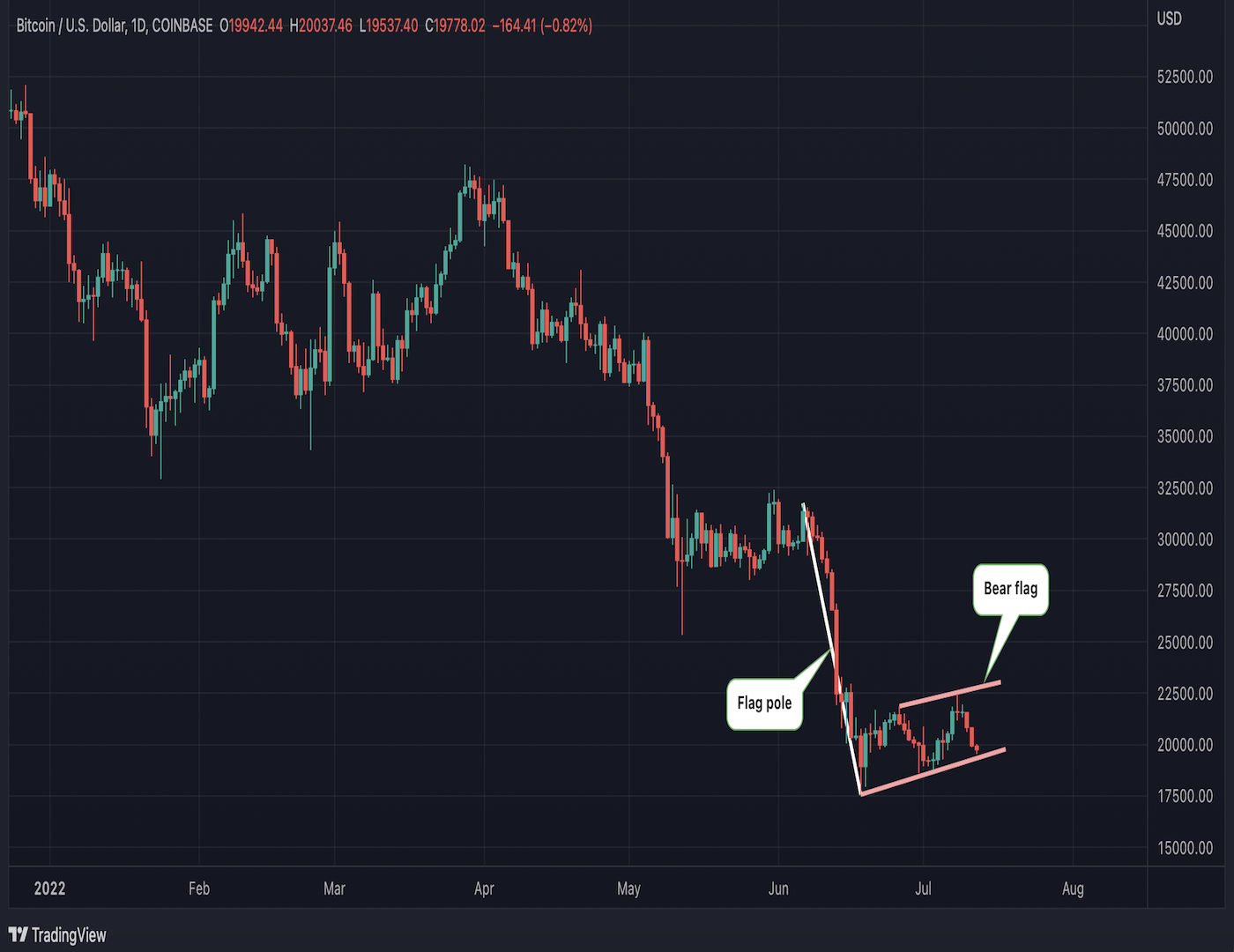Bitcoin's recent trading action has formed a pattern called a "bear flag." That looks like a pause in the past months' market downtrend, and it usually leads to a fresh move lower.
What's especially troubling at the moment is just how lopsided the positioning has become in the crypto options market. The dynamic might aggravate any sell-off triggered by a flag breakdown.
The bear flag resembles an upside-down flag on a price chart. First there is a strong move down (the flagpole) and then a minor price bounce (the flag). Under the conventional wisdom of technical analysis (the art of price-chart reading), an asset's price usually drops roughly the length of the pole following the flag breakdown. Hence, the bear flag is considered a bearish continuation pattern.
In the case of bitcoin (BTC), the corrective bounce from the June 18 low of $17,601 to Friday's high of $22,400 represents the flag, and the preceding decline from $32,500 is the flagpole. Trend lines connecting June 18 and July 3 lows – and June 26 and July 8 highs – reveal the flag.
"It's a bear flag and the breakdown could happen soon," said Griffin Ardern, a volatility trader at crypto asset management firm Blofin.

Bitcoin's daily chart showing a bear flag pattern (TradingView)
A breakdown – likely if the price finishes below the lower end of the flag at the end of a trading date – would imply that the broader downtrend is resuming, opening the doors for a retest of the recent low of $17,601. Below that, key support is seen at the psychological level of $15,000 and the June 2019 high of $13,880.
Technical analysis is subjective; price patterns often fail, trapping chart-focused traders on the wrong side of the market. Note that while the daily chart flag pattern is signaling downside risk, other price-chart patterns are sending conflicting signals: As previously reported, technical analysis of the long-term moving price average as well as several blockchain data indicators suggest the bitcoin market is close to bottoming or maybe already on the way back up.
Options market trading could add to volatility
That said, should the flag end with a downside move, the resulting fall might be exacerbated by the hedging activity of options market participants, mainly market makers – entities with a contractual obligation to maintain a healthy level of liquidity on an exchange.
Market makers are always on the opposite side of investors' trades and maintain a neutral portfolio through continuous buying and selling of the underlying asset as the price swings.
According to Ardern, market makers currently hold "short put" positions; that essentially means the market makers have taken the opposite side of options traders who are betting on further price declines; so the market makers stand to lose if bitcoin resumes the downtrend.
If the market were to turn lower, it might set off a mad scramble for the market makers to quickly cover their losing positions – exacerbating the price action on the downside.
"When the price falls in the future, the hedging behavior of derivatives investors will further aggravate the decline," Ardern said.
Bitcoin was last seen trading near 1% lower on the day near $19,700, with investors awaiting Wednesday's U.S. inflation data that is likely to cement the case for continued faster withdrawal of liquidity by the Federal Reserve.
"The inflation print has been a key source of market movement this year, and we expect an uptick in vols [volatility] ahead of the event," the Singapore-based options trading giant QCP Capital, said in a market outlook tweeted early Tuesday.
DISCLOSURE
Please note that our privacy policy, terms of use, cookies, and do not sell my personal information has been updated.
The leader in news and information on cryptocurrency, digital assets and the future of money, CoinDesk is a media outlet that strives for the highest journalistic standards and abides by a strict set of editorial policies. CoinDesk is an independent operating subsidiary of Digital Currency Group, which invests in cryptocurrencies and blockchain startups. As part of their compensation, certain CoinDesk employees, including editorial employees, may receive exposure to DCG equity in the form of stock appreciation rights, which vest over a multi-year period. CoinDesk journalists are not allowed to purchase stock outright in DCG.

:quality(70)/cloudfront-us-east-1.images.arcpublishing.com/coindesk/4VEAPUGMQJBSJAMAAD7UADPDTQ.jpg)
:quality(70)/cloudfront-us-east-1.images.arcpublishing.com/coindesk/RFIVNCFNANGSVCBTM3ZJZDTIQE.jpeg)
:quality(70)/cloudfront-us-east-1.images.arcpublishing.com/coindesk/LWJ3MUD5UFDRVLTLGBDJNKQIVM.jpeg)
:quality(70)/cloudfront-us-east-1.images.arcpublishing.com/coindesk/JO37HFK7CBGA7IRKS2OFYVXEK4.jpg)